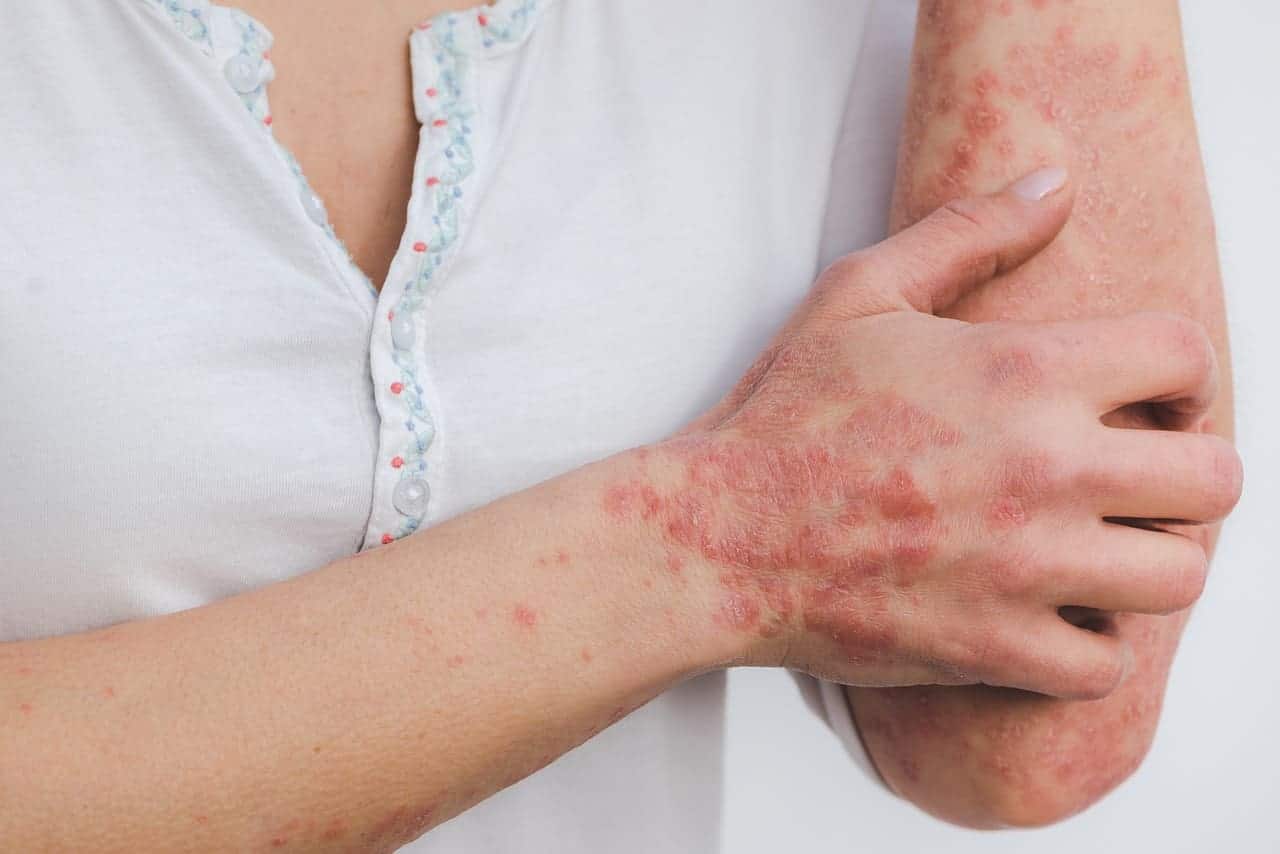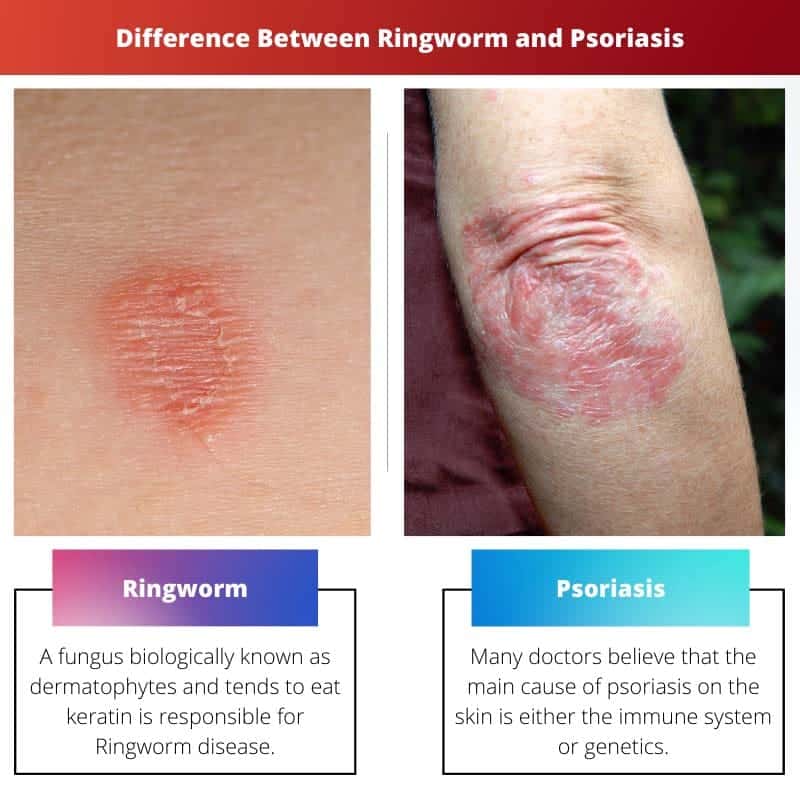The skin on the body is one of the very vital organs. It protects the fragile nerves from the dangerous and toxic components of the outer world.
Generally, skin can heal itself, but some diseases require more attention. Ringworm and Psoriasis are two such diseases that deliver a lot of damage to the skin.
Key Takeaways
- Ringworm is a contagious fungal infection; psoriasis is a non-contagious autoimmune skin disorder.
- Ringworm causes circular, itchy, scaly rashes; psoriasis causes red, scaly patches with silvery scales.
- Ringworm is treated with antifungal medications; psoriasis is managed with topical treatments, light therapy, and systemic medications.
Ringworm vs Psoriasis
The difference between Ringworm and Psoriasis is that Ringworm is caused by dermatophytes fungus. In contrast, Psoriasis is caused by the rapid production of new skin cells to replace dead skin cells. The blisters of ringworm and psoriasis might look alike, but there is an apparent difference between them.

Ringworm is known as a very contagious fungal infection. When a person gets ringworm disease, many round red spots can be seen on his skin.
Ringworm occurs on the feet or head of the person. It can spread by touching infected objects or animals. A person with Ringworm should avoid skin-to-skin contact to avoid spreading the infection.
In the condition of Psoriasis, round red patches occur on the skin. It is caused by the body cells building up, causing various itchy Red blisters.
Psoriasis is known to belong to the immune system of a person. The worst thing about Psoriasis is that it can last years to an entire lifespan.
Comparison Table
| Parameters Of Comparison | Ringworm | Psoriasis |
|---|---|---|
| Cause | A fungus biologically known as dermatophytes and tends to eat keratin is responsible for Ringworm disease. | Many doctors believe that the main cause of psoriasis on the skin is either the immune system or genetics. |
| Affected areas | The shape of the rash caused by Psoriasis is round and irregular. | The shape of the rash caused by Psoriasis is round, and it is irregular. |
| Shape | The patches caused by ringworm are very itchy and can sometimes even feel burning on the skin. | Ringworm affects the hands or scalp of the person. It can also develop in the nails, making them crack. |
| Contagiousness | Ringworm is a contagious disease that spreads rapidly by physical touching or being in contact with infected skin. | Psoriasis is not a contagious disease. Hence, it does not spread rapidly by physical touch. |
| Rash feeling | The patches caused by ringworm are very itchy, and they can sometimes even feel burning on the skin. | Psoriasis is in the person’s joints, such as knees and elbows. It never develops in the nails. |
What is Ringworm?
Ringworm is a disease that happens on the skin. It is a type of dermatitis. Another word used for Ringworm is dermatophytosis, tinea, dermatophyte infection, etc.
Various Red spots can be seen on a person’s skin with Ringworm. It appears as a mere patch but soon develops into a blister.
If it happens to a person’s nails, they begin to crack and discolour. If the head is on the radar of this disease, the hair around the blister starts falling off.
It spreads very quickly, although it can be self-healed. But in the worst cases, Ringworm requires proper medical help to treat.
The name ‘Ringworm’ is a misnomer since the infection is not caused by any worm but by a fungus. Ringworm is called so because the wound or rash caused by infection takes after the worms.
Both humans and animals can suffer from Ringworm disease. Mainly it affects the areas like nails, feet, groin, scalp, beard, etc.
A person can adapt to doing various things to avoid getting Ringworm. For example, wash bedsheets at a certain time, wear clean clothes, dry wet areas in the house, etc.
Also, if a person is diagnosed with Ringworm, he should wear loose, light clothes. Some experts suggest putting Apple cider vinegar or Coconut oil on the affected area.
What is Psoriasis?
Dermatologists refer the Psoriasis disease as a protracted autoimmune condition. It is known to cause scaling on the surface of a person’s skin.
In Psoriasis, the body cells build up very rapidly in specific areas. These scales on the skin can have redness and inflammation, which is very common. The patches caused by Psoriasis are thick and silvery-white in colour.
In some cases, these patches crack, and this process results in bleeding. The psoriatic scales primarily affect the areas around joints such as elbows and knees. The other body parts Psoriasis can infect are the feet, neck, hands, face, etc.
Psoriasis disease has been divided mainly into five types: Pustular psoriasis, Guttate psoriasis, Inverse psoriasis, Plaque psoriasis, and Erythrodermic psoriasis.
Unlike ringworm, psoriasis is not contagious. It does not travel by skin-to-skin contact. Doctors have never been particular about the main reason that causes Psoriasis.
It is connected to the immune system and genetics. It happens when the white blood cells attack the skin cells by fault when fighting other infections.
Hence, the production of new skin cells gets rapid to replace the dead skin cells. Due to this fast production, dead skin cells don’t get enough to fall off, mixed with new skin cells, and a pile of cells forms on the skin’s surface.
This pile of cells develops into blisters known as Psoriasis.

Main Differences Between Ringworm and Psoriasis
- The patches caused by ringworms do not frequently change, while patches of psoriasis can be red and then grow into grey colour being cranky.
- The patches in ringworm can shift from one area to another. On the other hand, patches in psoriasis grow thicker in one area.
- The blisters caused by ringworm are very itchy compared to psoriasis while psoriatic patches aren’t that itchy but can become so intense that the person gets a fever.
- Ringworm is a contagious disease that spreads by physical contact. On the other hand, Psoriasis is not a contagious disease.
- The major cause of ringworm disease is a fungal infection while the main reason that causes Psoriasis is genetics and the immune system.

- https://link.springer.com/content/pdf/10.1007/s11046-008-9101-8.pdf
- https://www.sciencedirect.com/science/article/pii/019096229591336X

Although the article explains the differences between ringworm and psoriasis, it could have included more about the causes and the genetic factors that lead to Psoriasis. A more in-depth analysis of Psoriasis would have been appreciated.
I found the comparison table to be extremely useful in understanding the key differences between ringworm and psoriasis. It’s a great way to present detailed information in a structured format. A visually appealing and informative article.
The article has succeeded in simplifying the complex information about ringworm and psoriasis. It is a valuable resource for both medical professionals and individuals seeking information about these dermatological conditions.
The depth of knowledge and comprehensive information provided in this article are commendable. The explanation of every aspect and the difference between ringworm and psoriasis is well written. It has helped me to understand the differences between the two and the treatments to be followed to cure it.
I completely agree with you, Achapman. The details of ringworm and psoriasis are explained in a clear and concise manner, making it easier for readers to understand.
The lighthearted approach to explaining such serious medical conditions by using words like ‘The name ‘Ringworm’ is a misnomer since the infection is not caused by any worm but by a fungus’ adds a touch of humour and ease for the readers. Well done!
The reference links provided at the end of the article are extremely helpful. It shows that the content is backed by scientific research and genuine sources. A very informative article indeed.